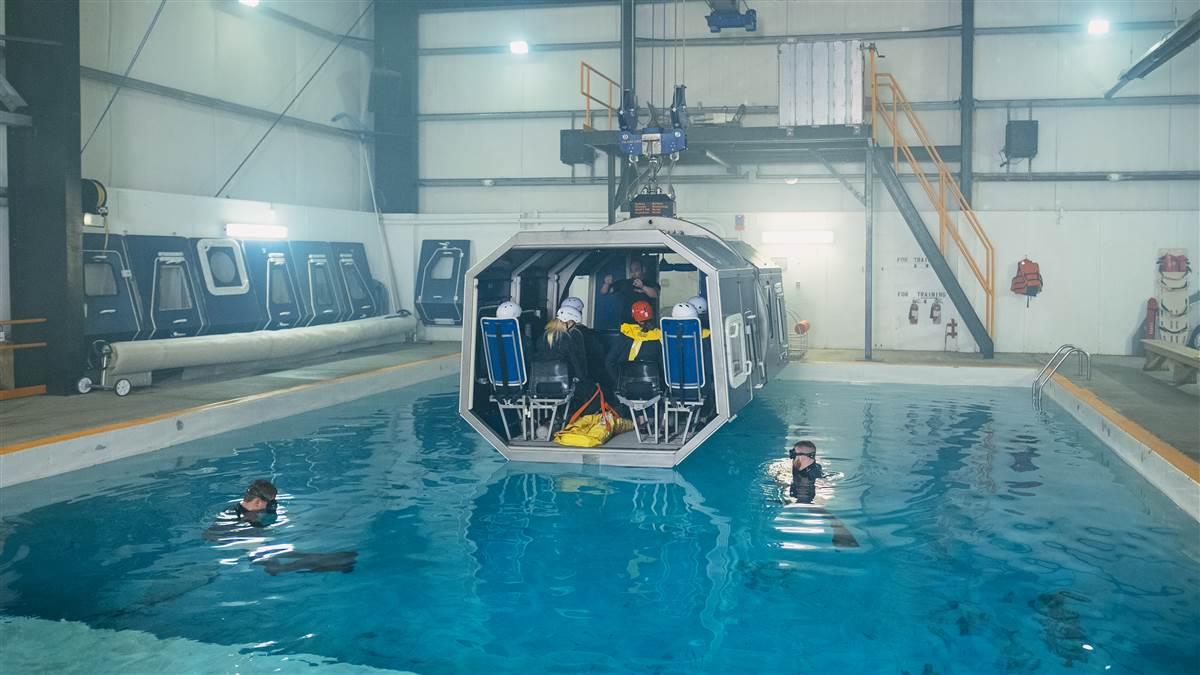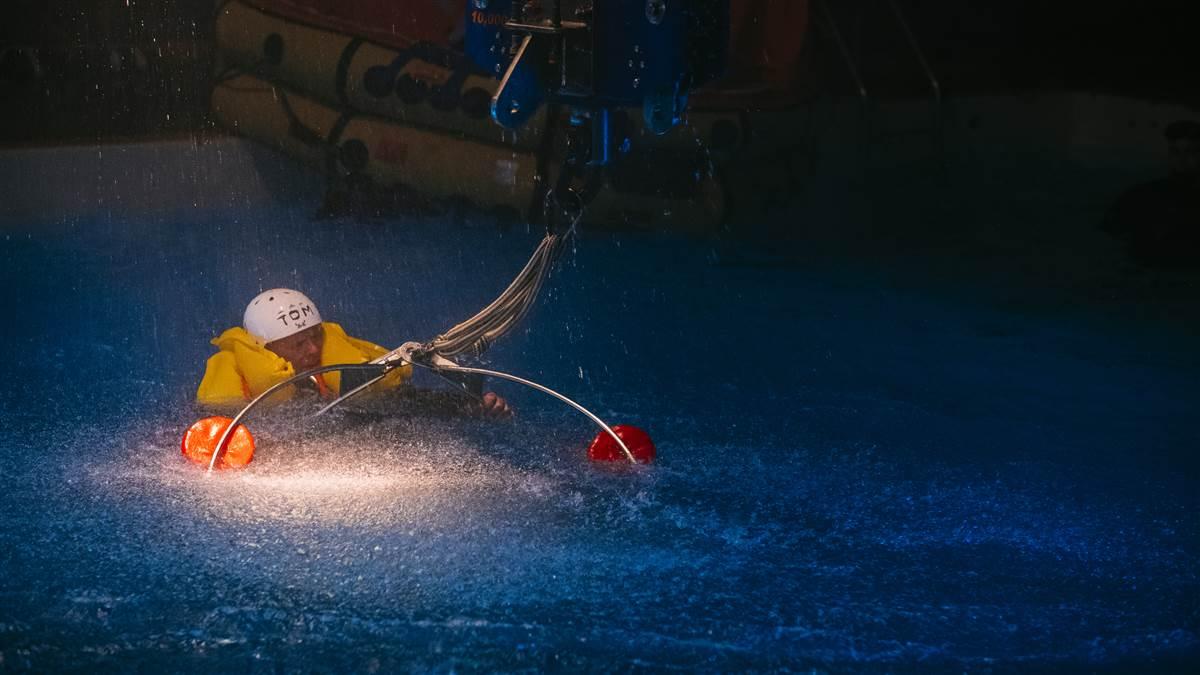'Ditching, ditching!'
Prepping for a water landing

One training exercise at Survival Systems USA teaches how a group can remain comfortably afloat by forming a chain, or making a mat by intertwining each others’ legs.
Photography by Joe Ferraro
Slowly at first, then in a gushing torrent. I’m in the brace position, with my hands up by my neck, holding on to the shoulder harnesses. The water’s now up to my chest. I take in a deep breath, and then I’m submerged. In the dark. Then the cabin rolls inverted. Great. With this kind of stress, I’ve got about 15 seconds or so to wait for the movement to stop, feel my way to the door handle, open the door, release my four-point harness, exit the cabin, and swim to the surface.
It sounds simple, but this is a battle against panic. Stay calm, know the relative locations of door handles and escape hatches, move deliberately, and you can make it out of a sinking airplane. Release the seatbelt too early, lose your cool, flail about, or become lost in the cabin, and you’ll drown. Psychologically and physiologically, both you and your body know this. Your job is to try to ignore the panic.
Ditchings are rare. And apart from a brief passage in the Aeronautical Information Manual (AIM Chapter 6-3-3), there is little practical advice on the gritty procedural details for managing a ditching situation—let alone practicing one under controlled, realistic conditions. That’s where Survival Systems USA comes in. The 36-year-old firm based at the Groton, Connecticut, airport specializes in survival training—with an emphasis on underwater egress and water survival. The company’s one-day training course costs $800 and runs from 8 a.m. to 5 p.m. Other courses, designed for military clients, are held at locations around the United States.
 The Groton facility’s training relies heavily on a sophisticated dunker, dubbed the Modular Egress Training Simulator (MET). Suspended from an overhead crane, the dunker is set up as an aircraft cabin, complete with control yokes and removable doors. Using remote controls, the “cabin” can be winched up and down, as well as rotated. Winches also can be used to give students practice using helicopter-recovery gear such as rescue baskets or “horse collars.” For added realism, huge, ceiling-mounted fans can duplicate a helicopter’s downwash and create waves in the pool. What about heavy rain, the sound of rotor blades, and thunder? Not a problem, thanks to ceiling-mounted fire hoses and speaker systems.
The Groton facility’s training relies heavily on a sophisticated dunker, dubbed the Modular Egress Training Simulator (MET). Suspended from an overhead crane, the dunker is set up as an aircraft cabin, complete with control yokes and removable doors. Using remote controls, the “cabin” can be winched up and down, as well as rotated. Winches also can be used to give students practice using helicopter-recovery gear such as rescue baskets or “horse collars.” For added realism, huge, ceiling-mounted fans can duplicate a helicopter’s downwash and create waves in the pool. What about heavy rain, the sound of rotor blades, and thunder? Not a problem, thanks to ceiling-mounted fire hoses and speaker systems.
The course begins with a morning classroom session, taught by Survival Systems’ Dan McInnis. Here, I and my seven classmates (who fly everything from Cessna 182s to Gulfstreams) learn the basics. Seventy percent of passengers will most likely panic in a ditching; about 30 percent may be able to help with cabin egress. Most people are not even willing to realize that something can go wrong. So it’s up to pilots to learn how to take control. It starts with communicating about an abnormal situation to those inside the cabin, and to air traffic control—in that order.
The brace position is important because McInnis says most injuries happen on impact. Pilots are especially susceptible to head injuries, because the airplane or helicopter must be flown to the surface. Broken thumbs and wrists can happen if you don’t remember to grip the control wheel with your thumbs outside of the controls. Get life vests on if there’s time—three minutes to impact is usually enough, but 90 seconds isn’t. Make sure everyone keeps their feet flat on the floor, and not under the seats, which could collapse on impact and pin the occupant.
Then came a discussion about cockpit resource management during the post-ditching egress phase, when someone must be in charge—as pilot in command, that’s you. Then came a unit on hypothermia and underwater disorientation. The antidote to underwater disorientation? Learning tactile reference points that can lead you to a door or window release handle or latch.
Which brings us to the afternoon pool sessions. The class was issued coveralls, then it was into the water to practice inflating the vests and life rafts. Good to know, since most of us have never inflated either. We also learned how to right a raft that inflates upside down: put your foot on the inflation bottle to make a pivot point, grab the righting strap at the bottom of the raft, and haul it right-side up. Then it was more practice entering the raft, as well as floating together in a chain and as a group to maximize our buoyancy and conserve heat and energy. In a pinch, however, we were told that climbing into a large trash bag in the water can go a long way toward preventing hypothermia.
Things got quiet when dunking time drew near. Speaking for all of us, one student sighed, “Let’s just get this over with.”
First came practice with a Shallow Water Egress Trainer (SWET) chair. It’s a small, triangular chair structure with a plastic side panel you can remove by pushing on it. You start upright in the chair, then they flip you upside down, and that’s when you do the drill—push out the panel, release the belt, and get out. Sound easy? It isn’t—at first.
Soon, the dunker is winched into position and the first group climbs aboard. The first step is a surface ditching simulation, where you’re spared a dunking but learn where the door latches are. The real fun starts with the first two, true dunkings. After the “ditching, ditching” call, the winch drops you in the drink, and then rotates on its side. “One breath won’t be enough,” I thought during one escape, as I fumbled to find the latch.
The next immersion was to the inverted position, which was disorienting but doable. The practice was kicking in. I should mention that McInnis and two scuba divers are in the pool with you, ready to rescue you in case of a problem.
The last two dunkings were in the dark, something that somehow magnifies the innate, primordial fear of drowning. The final dunk—again, to the inverted—had a twist. We had to move across the cabin to get to an exit door. All the previous egresses were through adjacent doors.
A well-rounded pilot should know ditching procedures—even if you only fly across small bodies of water. I know a pilot who lost her engine immediately after taking off from an airport on the Florida coast. Turning back was not an option, so she ditched offshore with a cabin full of young passengers. Luckily, all turned out well.
But what if you’re not lucky, the cabin floods, and the airplane begins to sink? Attending a course like Survival Systems’ may well be your best chance of saving the day.
Email [email protected]

 AOPA Editor at Large Thomas A. Horne will be among the presenters of a water survival course at the AOPA Fly-Ins at Groton on October 6 and Tampa on October 27.
AOPA Editor at Large Thomas A. Horne will be among the presenters of a water survival course at the AOPA Fly-Ins at Groton on October 6 and Tampa on October 27.
